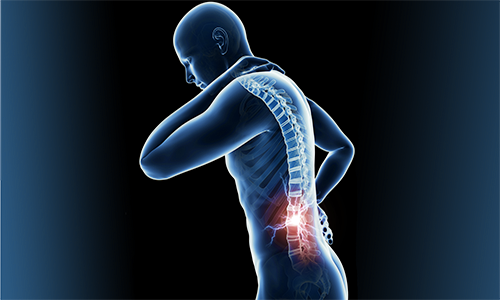
Spinal Cord Stimulation
Certain types of chronic pain are caused by irritation of the nervous system. These so-called neuropathic pains often manifest as pain in the lower back or the legs.
According to studies of the German Pain Association e.V. and the German Pain Society e.V. with 69% back pain is the most common kind of chronic pain. 8 to 10 million Germans live with chronic back pain. The American National Institutes of Health (NIH) estimate that more than 10% of the US population are affected by chronic pain.
Such pain can often be treated by physiotherapy, surgery, or alternative therapies. In cases where no other therapy is effective in reducing pain electrical stimulation of the spinal cord or the dorsal root ganglia can help (Dones & Levi 2018; Hunter et al., 2018).
For this purpose electrodes are implanted in the space above the spinal cord or in the vicinity of the spinal ganglia and connected to stimulation generators. The electrical stimulation pulses delivered to the tissue provide relief from pain sensation.
There are already a number of commercially available and clinically approved neurostimulators for spinal cord stimulation. About 15,000 patients receive such an implant every year. Spinal cord stimulation is currently the most commonly used form of neurostimulation.
Some implant systems are already able to work in a so-called closed loop with a small number of channels. In these cases stimulation intensity is adjusted either to the body position (Denison & Litt, 2014) or to measured electrical nerve activity (Russo et al., 2018). At the same time the numbers of channels of the clinically approved systems continuously.
High-channel and more complex closed-loop interactions with the nerve tissue could probably further improve therapeutic efficiency.
The CorTec electrodes, especially the flat °AirRay Grid Electrodes are suitable for spinal cord stimulation. As components of complete systems they can be customized and optimized in high-resolution designs to the application at hand. This provides greater spatial resolution of the area to be stimulated, which can help to hit the pain mediating areas and to develop new and more accurate therapies.
Applying °AirRay electrodes in conjunction with the Brain Interchange System also offers the option of combining specially designed electrode designs with long-term closed-loop pain therapy: The Brain Interchange technology is able to respond to neural activity and adjust the stimulation accordingly.
With its high number of channels, combined with the ability to both record and stimulate at all contacts, the Brain Interchange System provides maximum technical flexibility for a therapy that can adapt to the needs of the patient.
The CorTec °AirRay electrodes can be used in a variety of designs in scientific studies and as components of complete therapeutic systems. The Brain Interchange System is currently under development. Initial clinical pilot studies are in preparation to demonstrate safety and functionality of the system.
For the general public
Scientific Literature
Spinal Cord Stimulation
Spinal Cord Stimulation for Neuropathic Pain: Current Trends and Future Applications.
Dones I, Levi V.
Brain Sci. 2018 Jul 24;8(8). pii: E138. doi: 10.3390/brainsci8080138. Review.
Dorsal root ganglion Stimulation
Hunter CW, Sayed D, Lubenow T, Davis T, Carlson J, Rowe J, Justiz R, McJunkin T, Deer T, Mehta P, Falowski S, Kapural L, Pope J, Mekhail N.
Neuromodulation. 2018 Aug 7. doi: 10.1111/ner.12796. [Epub ahead of print]
Closed-Loop Stimulation
Russo M, Cousins MJ, Brooker C, Taylor N, Boesel T, Sullivan R, Poree L, Shariati NH, Hanson E, Parker J.
Neuromodulation. 2018 Jan;21(1):38-47. doi: 10.1111/ner.12684. Epub 2017 Sep 18.
Closed-loop neurostimulation: the clinical experience.
Sun FT, Morrell MJ.
Neurotherapeutics. 2014 Jul;11(3):553-63. doi: 10.1007/s13311-014-0280-3. Review.
Denison T, Litt B.
Neuromodulation. 2014 Jun;17 Suppl 1:48-57. doi: 10.1111/ner.12170.